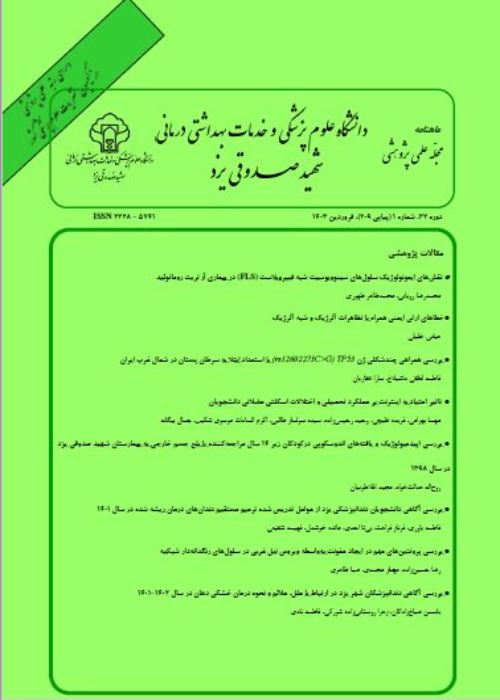Epidemiology of COPD in Inpatients
Author(s):
Abstract:
Introduction
Chronic obstructive pulmonary disease (COPD) is one of the leading causes of morbidity and mortality in both industrialized and developing countries and is projected to be the third most common cause of death in both men and women by the year 2020. Methods
This descriptive (case series) study evaluated risk factors of 300 COPD patients admitted in Shahid Sadoughi and Shohadaye Kargar hospitals of Yazd using the respiratory disease questionnaires. Results
81.34% were men, 18.66% were women and their age range was between 33-92 years but majority of patients were in the 65-74 years age group (41.34%). Mean age of women were more than men which was significant (70.858.68). The results were as follows: Cigarette smoking was the only risk factor in 18.7% (23% of men), 43.6% had occupational COPD(87.5% of Women & 33.6% of Men), while 35% had both the risk factors (5.4% of Women & 41.7% of Men) and 2.7% had an underling disease as the only risk factor.55% of patients had only one risk factor (76.8% of Women & 50% of Men), 39.3% had two and 5.6% of patients had more than two risk factors. 77.7% of patients had occupational exposure overall, the most frequent occupation was farming but in women it was bread making in the bakery. The most frequent underling disease was HTN (29%) but the most frequent related disease was allergy (9.3%). There was a relationship between number of risk factors, duration of symptoms and disease severity but sex, type of job and different risk factors had no significant effects on it. Mean of FEV1 did not differ significantly in men and women (35.7416.57). Conclusion
Majority of patients were more than 65 years of age. The most frequent risk factor was occupational exposure that shows its important role in development of disease in both men & women. It is therefore necessary to perform screening tests like spirometry in this high risk group. Type of job, risk factor and sex had no effects on disease severity but number of risk factors had a significant effect this indicates that combination of risk factors is more important than type of risk factor for example we should try to prevent smoking in people with occupational exposure. Duration of symptoms also had a significant effect on severity and therefore emotional support, intensive treatment and rehabilitation programs should be considered in patients with chronic symptoms.Keywords:
Language:
Persian
Published:
Journal of Shaeed Sdoughi University of Medical Sciences Yazd, Volume:17 Issue: 1, 2009
Page:
3
magiran.com/p628543
دانلود و مطالعه متن این مقاله با یکی از روشهای زیر امکان پذیر است:
اشتراک شخصی
با عضویت و پرداخت آنلاین حق اشتراک یکساله به مبلغ 1,390,000ريال میتوانید 70 عنوان مطلب دانلود کنید!
اشتراک سازمانی
به کتابخانه دانشگاه یا محل کار خود پیشنهاد کنید تا اشتراک سازمانی این پایگاه را برای دسترسی نامحدود همه کاربران به متن مطالب تهیه نمایند!
توجه!
- حق عضویت دریافتی صرف حمایت از نشریات عضو و نگهداری، تکمیل و توسعه مگیران میشود.
- پرداخت حق اشتراک و دانلود مقالات اجازه بازنشر آن در سایر رسانههای چاپی و دیجیتال را به کاربر نمیدهد.
In order to view content subscription is required
Personal subscription
Subscribe magiran.com for 70 € euros via PayPal and download 70 articles during a year.
Organization subscription
Please contact us to subscribe your university or library for unlimited access!


